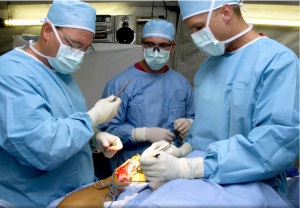 Many conditions that result in pain in the neck, back, head, legs and arms like bulging and herniated discs, degenerative disc disease, sciatica, pinched nerves and radiating pain in the extremities can be attributed to compressed discs. If you have compressed discs and experience any of the aforementioned conditions, it is because the spine is putting pressure on the disc. Compressed discs may be caused by bad posture, improper body mechanics, repetitive stress or even injuries. All these can lead to the vertebrae compressing the discs or even making these slip out of alignment.
Many conditions that result in pain in the neck, back, head, legs and arms like bulging and herniated discs, degenerative disc disease, sciatica, pinched nerves and radiating pain in the extremities can be attributed to compressed discs. If you have compressed discs and experience any of the aforementioned conditions, it is because the spine is putting pressure on the disc. Compressed discs may be caused by bad posture, improper body mechanics, repetitive stress or even injuries. All these can lead to the vertebrae compressing the discs or even making these slip out of alignment.
Compressed discs can cause bulges or herniation of a nerve and may make a disc become brittle. Compounding this problem is the fact that compressed discs can inhibit the flow of nutrients which it needs to heal itself.
For patients dealing with disc compression, two of the most common treatment options are chiropractic adjustment and surgery.
Another treatment option that has fast become popular in recent years is spinal decompression therapy. This therapy decompresses discs through the use of traction, distraction and the positioning of the patient’s body. Today’s method of decompression, NYC residents ought to know, is an update of previous traction techniques like the use of inversion tables that have been around for centuries. These older techniques can be quite uncomfortable and offer marginal results.
In a modern-day decompression therapy, a patient lies on the spinal decompression table where distraction force is applied to a pre-determined area on the spine. A computer controls the amount of force applied which elongates the spine and creates a vacuum which allows the discs to come back to their original shape. Patients who have undergone this treatment report that they hardly felt any pain or discomfort.
Decompression produces effective results in a two-fold manner. First, it reduces pressure on spinal discs and facet joints while creating a vacuum effect which can pull in herniation. Second, it facilitates healing by encouraging blood flow into the disc. This blood flow brings in vital nutrients that allow discs to heal themselves.
Normally, a patient needs to undergo between 15 to 20 decompression sessions. In most cases, the treatment is complemented by a physical therapy session. Do note that the number of sessions will vary from one person to another and your doctor will recommend the number of therapy sessions you need to finish after a thorough evaluation. In most cases, patients experience noticeable relief after just a few decompression sessions.














